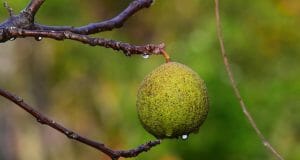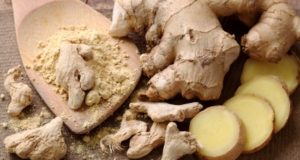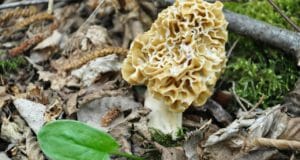 Most people never give the food they buy at the supermarket a second thought. They buy it, cook it, and eat it. However, if a cataclysmic event suddenly caused that food to be gone, what would happen? Suppose a nuclear war or some other massive devastation wiped out all of the plant life? Where would we get food? The food chain would be missing a vital link.
Most people never give the food they buy at the supermarket a second thought. They buy it, cook it, and eat it. However, if a cataclysmic event suddenly caused that food to be gone, what would happen? Suppose a nuclear war or some other massive devastation wiped out all of the plant life? Where would we get food? The food chain would be missing a vital link.
If we didn’t have plants, we would not only have a food problem; we would have an atmospheric problem. Our very existence depends on plants. However, for the sake of brevity, consider food crops. There are thirty basic crops that make up the majority of the diet of people around the world. If these were to disappear, what would people do? The answer lies in seed banks.
What are Seed Banks?
The most straightforward definition of a seed bank is a holding place for seeds. The seeds are deposited into the storage area for withdrawal at a later date. Scientists have set up seed banks in the event that crops die out and need to be restored. The storage process that is used allows the seeds to be stored for hundreds of years.
There are many seed banks around the world. At last count, there were 1,400 seed banks. There is one global seed bank that many people refer to as the Doomsday Vault. This seed bank is the Svalbard Global Seed Vault. The Svalbard Seed Vault is a repository and backup for all other seed banks. This redundancy is important in the event one or more of the other seed banks are destroyed.
Why Store Seeds
There are many reasons that a seed bank is an important consideration for survival. The world doesn’t have to go into a nuclear war to have major damage to food crops. Some of the major reasons for having seeds banks include:
- Climate change: Severe climate change would bring radical changes to the planet. Many plants might not be able to survive drastic changes. There is also the possibility that a severe weather change will cause new pests to enter the environment. If this happens, plants may suffer.
- Natural disasters: Hurricanes, floods, tidal waves, and other natural disasters can cause major damages to the area’s ecosystem. If there are no seeds in the seed banks, crops cannot be restored.
- Disease: Plant disease can quickly eradicate crops. It doesn’t take long, and it can go undetected until it is too late.
New Survival Seed Bank™ Lets You Plant A Full Acre Crisis Garden!
This short, but powerful list proves that there doesn’t have to be a nuclear war in order for plant life to be destroyed. It can be as simple as a climate change that alters the plant’s capability to grow.
Seeds Stored
It would be practically impossible to store one of every seed of every plant that exists on Earth. There are literally millions of plant species. This brings us to the question of who decides which plant seeds are preserved and which ones are not.
The answer is not as simple or across the board as you might think. Each seed bank around the world has different seeds in storage. The decisions are typically based on what is locally grown in the area. Some of the food banks may solely focus on plants that are native to their area; however, most try to include globally diverse plants that are beneficial to society. These are all edible plants that are considered necessary.
Storing Seeds
Once a decision on which seeds to store have been made, scientists will begin the collection process. Most seeds are collected when the fruit is ripe. However, some plants will keep their seeds for longer periods, which allow an extended collection period. Other plants might not seed on a regular basis, and thus require more than one collection.
Scientists and other workers manually collect the seeds using pole cutters, tweezers, nets, buckets, or whatever the species requires them to use in order to get the seed without damaging it. Once collected, all of the details about the species and that particular seed are recorded, such as:
- Plant name (common and species)
- Location
- Soil type
- Any other data available.
The seeds are then assigned a number. This could be compared to the deposit number you have when you make a deposit.
Seeds are then cleaned and dried in a high-humidity, high-temperature room and sealed in containers that have no air. Once this process is complete, the seeds are frozen at 4°F.
This process works for almost all plants. However, some plants, like bananas, don’t produce seeds. When this is the case, tissue from the living plant must be collected and stored in-vitro, much like human embryos are stored. The living tissue from the plants are placed in liquid nitrogen and stored at -320°F.
This all sounds good in theory; however, even these carefully stored seeds will eventually die and need to be replaced. It may be hundreds of years from now, but it will happen. This is why records are vitally important in the seeds banks. Someone has to know when it is time to replace the seeds with fresh ones. It is a good bet that the scientist who put them in the bank won’t be around when it’s time to replace them.
Ownership
Ultimately, the question becomes, who owns the seeds and who can use them? Typically, the country that owns the seed bank owns the seeds. However, the Svalbard Vault in Norway acts as a repository for all countries. This means that whoever deposits the seeds owns them. The owner of the seeds can withdraw them at any time and use them or lend them to a country in need.
It is nice to know that if our country, or any other country, suffers a cataclysmic event that we have options to restore our plant life. If we did not, the food chain and entire ecosystem would ultimately collapse and human life would ultimately expire. Seed banks serve a great purpose and should be part of every country’s plan for survival.
©2012 Off the Grid News
 Off The Grid News Better Ideas For Off The Grid Living
Off The Grid News Better Ideas For Off The Grid Living




